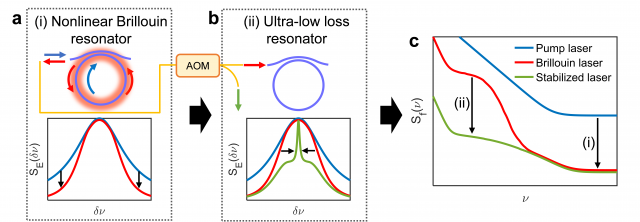Laser stabilization with ultra-low-loss and nonlinear resonators
This is our recent work now posted on ArXiv: Liu, Kaikai, et al. "Photonic circuits for laser stabilization with ultra-low-loss and nonlinear resonators." arXiv preprint arXiv:2107.03595 (2021).

The process of laser stabilization using nonlinear and ultra-low loss photonic integrated resonators is illustrated in Fig. 1. The output from a pump laser such as a semiconductor laser, represented as a blue arrow in the upper part of Fig. 2a. This nonlinear SBS process reduces the spectral energy in the Lorentzian wings of the S1 lineshape as illustrated in the SE(dn) red curve. A tunable single sideband (SSB), with identical lineshape to S1, is generated using an acousto-optic modulator (AOM) and is frequency locked to the ultra-low loss linear resonator to reduce the close-to-carrier noise energy (Fig. 1b). The spectral energy of the low frequency noise in the SSB is frequency discriminated by the ultra-low loss resonator to produce a narrowed Gaussian lineshape, that is close to Lorentzian, at frequencies near the center carrier frequency (green curve in Fig. 1b). At the mid-frequencies, the lineshape takes on a Gaussian quality as it transitions from the wings towards the center. The resulting stabilized laser lineshape (green curve) can be further understood from the frequency noise spectral density (as illustrated in Fig. 2c offset from carrier). The unstabilized pump (Sf(n) blue) has a high frequency white noise floor that is directly related to its fundamental linewidth and more specifically the energy in its lineshape wings. The Brillouin nonlinear resonator reduces this high frequency white noise (i) as illustrated in its frequency noise spectrum (red), resulting in a reduction in the wing spectral energy in S1 that can be several orders of magnitude (the curves in Fig. 1c are schematically represented on a logarithmic plot). At mid- to low-frequencies, the emission (S1) is dominated by frequency noise from thermorefractive and photothermal effects in the waveguide resonator that broadens the lineshape, forming the Gaussian-like shape at mid-frequencies, as well as technical noise sources at low frequencies (e.g., vibration and environmental effects) determine the degree of near-carrier linewidth reduction (red). The thermorefractive noise (TRN) contribution is minimized by maximizing the optical mode volume in the ultra-low loss resonator, and stabilization can be improved by increasing the resonator quality factor (Q). Locking the Brillouin output S1 to the ultra-low loss resonator using a high gain PDH loop reduces (stabilizes) the lower frequency noise components (ii) and results in the noise spectrum (Sf(n) green). The stabilized laser output will take on the low frequency noise qualities of the ultra-low loss resonator, which are determined predominately by thermorefractive noise and technical noise sources. The resulting stabilized lineshape is characteristic of the green curve in Fig. 1b, with two white noise-like flat frequency regions. By combining nonlinear and ultra-low loss integrated resonators, laser stabilization and linewidth reduction can be achieved.

In this work, we demonstrate a significant advance in photonic integrated laser stabilization, achieved by locking an ultra-high Q nonlinear 1550 nm Si3N4 waveguide Brillouin laser resonator to an ultra-low loss Si3N4 waveguide resonator. Using this configuration, we demonstrate an integral 330 Hz linewidth and Allan deviation of 6.5×10-13 at 8 ms, the lowest linewidth and highest stability reported for an all-waveguide design to the best of our knowledge. Both integrated resonators are a dilute optical mode Si3N4 design with large mode-volume and high Q. The intrinsic 56.4 Million Q corresponds to 0.47 dB m-1 propagation loss, with a loaded Q of 28.2 Million, a 0.05 dB m-1 absorption-limited loss, and a ~2×106 μm3 mode volume (~27 μm2 optical mode area and roundtrip length of 7.43 cm). The stabilized laser frequency noise is reduced in two spectral bands. High frequency offset from carrier noise (>100 kHz) is reduced in the nonlinear cavity through fundamental linewidth narrowing of stimulated Brillouin scattering (SBS) lasing with a short phonon lifetime, long photon lifetime, high optical Q and large mode-volume. The lower frequency offset from carrier noise (<10 kHz) is reduced with the ultra-low loss reference cavity through a combination of narrow linewidth cavity frequency discrimination, and low thermorefractive noise from the large mode volume. We compare the measured stabilized laser frequency noise to the cavity-intrinsic thermorefractive noise limit including the Pound-Drever-Hall (PDH) lock loop noise and simulated photothermal and thermorefractive noise. The stabilized laser emission reaches the thermorefractive noise limit down to 80 Hz frequency offset-from-carrier; this level of performance is achieved with the resonators located in an ambient environment with simple passive vibration damping isolation and without vacuum or thermal isolation.
